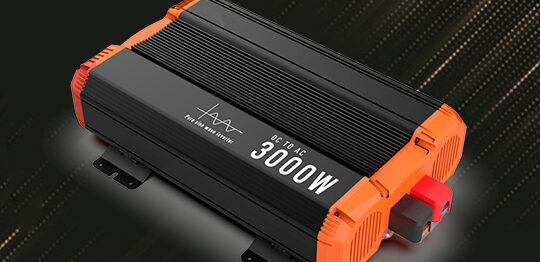How to choose a pure sine wave inverter with the right power?
For commercial reasons, most inverters express their power only in terms of maximum wattage, not in terms of the continuous wattage they support. In this section, we will explain the reasons for maximum and continuous wattage so that you can choose the right inverter for your needs.
All electrical and electronic equipment has a consumption when it is on (maximum consumption) and a lower consumption when it is running (continuous consumption), with the equipment, generally consuming about three times as much when it is on. (For special products, it will be higher)
Example. An energy-efficient motor that consumes 1,000 watts in operation will consume 3,000 watts at start-up. A TV that consumes 200 watts in operation will consume 600 watts when turned on.
Note: Motors that are not energy savers can consume anywhere from three to eight times the maximum at start-up.
All devices have an indication of their consumption and operating voltage, usually on the back. Some devices indicate their consumption in watts, expressed in (w), which is the same, and voltage in (v). Other devices indicate their consumption in amps or (amps), which must be converted to watts by multiplying amps by volts.
Example 1: A TV showing consumption of 1.3 amps 220 volts (1.3 x 220 = 286), the TV consumes 286 watts continuously and a maximum of 858 watts at the moment it is turned on.
Example 2: An energy-efficient refrigerator shown to consume 3.2 amps 220 volts (3.2 x 220 = 704), the refrigerator consumes 704 watts continuously and a maximum of 2112 watts at the moment it is turned on. The operation is the same for devices connected to 120 volts. (Amps per volt)
When choosing an inverter, take into account the sum of the watts of all the devices you want to connect.
Example: A 384-watt energy-efficient refrigerator, a 156-watt TV, five 24 watt energy efficient light bulbs, and a 60-watt fan, (384+156+24+24+24+24+24+60=720) for a total of 720 watts of continuous consumption and a maximum of 2160 watts at the moment of turn on. An inverter with a peak power of 2400 watts and a continuous power of 1200 watts is a good choice.
Note: If you choose a more powerful inverter, let’s say 5000 watts peak power and 2500 watts continuous power, it does not affect your equipment at all and does extend the life of the inverter because it works with less load than it was designed for, but it will be slightly more expensive.
For use in an RV, it is recommended to choose an inverter with 6000 watts of peak power and 3000 watts of continuous power or more.

